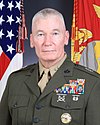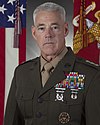
A brigade is a major tactical military formation that typically comprises three to six battalions plus supporting elements. It is roughly equivalent to an enlarged or reinforced regiment. Two or more brigades may constitute a division.

III Marine Expeditionary Force is a formation of the Marine Air-Ground Task Force of the United States Marine Corps. It is forward-deployed and able to rapidly conduct operations across the spectrum from humanitarian assistance and disaster relief (HA/DR) to amphibious assault and high-intensity combat.

The I Marine Expeditionary Force is a Marine Air Ground Task Force (MAGTF) of the United States Marine Corps primarily composed of the 1st Marine Division, 3rd Marine Aircraft Wing, and 1st Marine Logistics Group. It is based at Marine Corps Base Camp Pendleton.
Combat service support is a topic that is, broadly speaking, a subset of military logistics. However, combat service support is often more limited in depth, as the related groups primarily address factors supporting readiness for combat operations. The United States Department of Defense organizes various agencies providing services such as medical assistance, for example, akin to other nations' militaries.
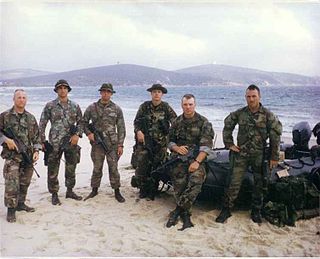
The Radio Reconnaissance Platoon is a specially trained Marine Corps Intelligence element of a United States Marine Corps Radio Battalion. A Radio Reconnaissance Team (RRT) was assigned as the tactical signals intelligence collection element for the Marine Corps Special Operations Command, Detachment One. Regular RRTs also participate in SOC operations during Marine Expeditionary Unit, or MEU(SOC), deployments.
In the United States Marine Corps, a Marine Air–Ground Task Force is the principal organization for all missions across the range of military operations. MAGTFs are a balanced air–ground, combined arms task organization of Marine Corps forces under a single commander that is structured to accomplish a specific mission. The MAGTF was formalized by the publishing of Marine Corps Order 3120.3 in December 1963, "The Marine Corps in the National Defense, MCDP 1-0". It stated:
A Marine air–ground task force with separate air ground headquarters is normally formed for combat operations and training exercises in which substantial combat forces of both Marine aviation and Marine ground units are included in the task organization of participating Marine forces.
A regimental combat team (RCT) is a provisional major infantry unit which has seen use by branches of the United States Armed Forces. It is formed by augmenting a regular infantry regiment with smaller combat, combat support and combat service support units.

The 11th Marine Expeditionary Unit is one of seven Marine Expeditionary Units currently in existence in the United States Marine Corps. The Marine Expeditionary Unit is a Marine Air Ground Task Force with a strength of about 2,200 personnel. The MEU consists of a command element, a reinforced infantry battalion, a composite helicopter squadron and a logistics combat element. The 11th MEU is currently based out of Marine Corps Base Camp Pendleton, California with headquarters in Camp Del Mar.
A Marine expeditionary force (MEF), formerly known as a Marine amphibious force, is the largest type of a Marine air-ground task force. A MEF is the largest building block of United States Marine Corps combat power.

The United States Marine Corps is organized within the Department of the Navy, which is led by the Secretary of the Navy (SECNAV). The most senior Marine commissioned officer is the Commandant of the Marine Corps, responsible for organizing, recruiting, training, and equipping the Marine Corps so that it is ready for operation under the command of the unified combatant commanders. The Marine Corps is organized into four principal subdivisions: Headquarters Marine Corps, the Operating Forces, the Supporting Establishment, and the Marine Forces Reserve.

The United States Marine Corps Forces Central Command is headquartered at MacDill Air Force Base in Tampa, Florida. The Commander, U.S. Marine Corps Forces, Central Command (COMUSMARCENT), is designated as the Marine Corps service component commander for Commander, U.S. Central Command (COMUSCENTCOM). MARCENT is responsible for all Marine Corps Forces in the CENTCOM Area of Responsibility (AOR), except for those assigned to the U.S. Special Operations Command (USSOCOM), and Special Operations Command, Central Command (SOCCENT).
In the United States Marine Corps, the ground combat element (GCE) is the land force of a Marine Air-Ground Task Force (MAGTF). It provides power projection and force for the MAGTF.
The United States Marine Corps' Anti-Terrorism Battalion was a specialized infantry battalion. The battalion was disbanded in 2013.

The 2nd Marine Expeditionary Brigade is a brigade of the United States Marine Corps. It is part of II Marine Expeditionary Force. It advertises itself as a "middleweight" crises response force of choice in the European and Southern Command Areas of Operation. It is able to "operate independently, as a service component, or to lead a Joint Task Force". Self-sufficient and interoperable, the 2nd Marine Expeditionary Brigade possesses a mix of command and control, combat power and specialized logistics. Operating as part of the greater Marine Corps team and with support from the United States Navy and other services, it can provide operational reach.

1st Marine Expeditionary Brigade is a unit in the I Marine Expeditionary Force and is the "middleweight" global crisis response force.
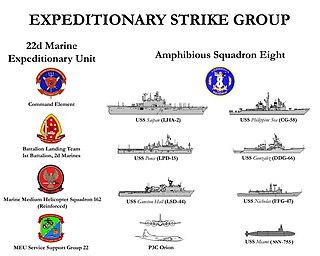
In the United States Navy, the expeditionary strike group (ESG) is a coordinated group of surface ships, aircraft, submarines, and other naval assets. In contrast to carrier strike groups (CSGs), which emphasize air power and are led by a supercarrier, ESGs are strongly suited for amphibious warfare and are led by an amphibious assault ship. The ESG concept was introduced in the early 1990s, based on the Naval Expeditionary Task Force. The U.S. Navy fields nine expeditionary strike groups.
In the United States Marine Corps, the aviation combat element or air combat element (ACE) is the aviation component of the Marine Air-Ground Task Force (MAGTF). The ACE is task organized to perform the six functions of Marine Corps aviation in support of MAGTF operations. The ACE is led by an aviation headquarters which employs rotary-wing, tiltrotor, and fixed-wing aircraft in conjunction with command and control, maintenance and engineering units.
In the United States Marine Corps, the logistics combat element (LCE), formerly combat service support element, is the portion of the Marine air-ground task force (MAGTF) responsible with providing logistical support. It provides equipment and personnel to keep the MAGTF running logistically.
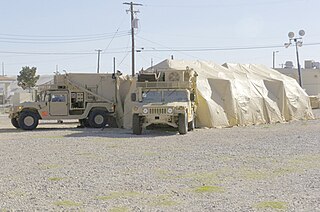
In the United States Marine Corps, the command element (CE) is the command and control force of a Marine Air-Ground Task Force (MAGTF). It provides C3I for the MAGTF.








